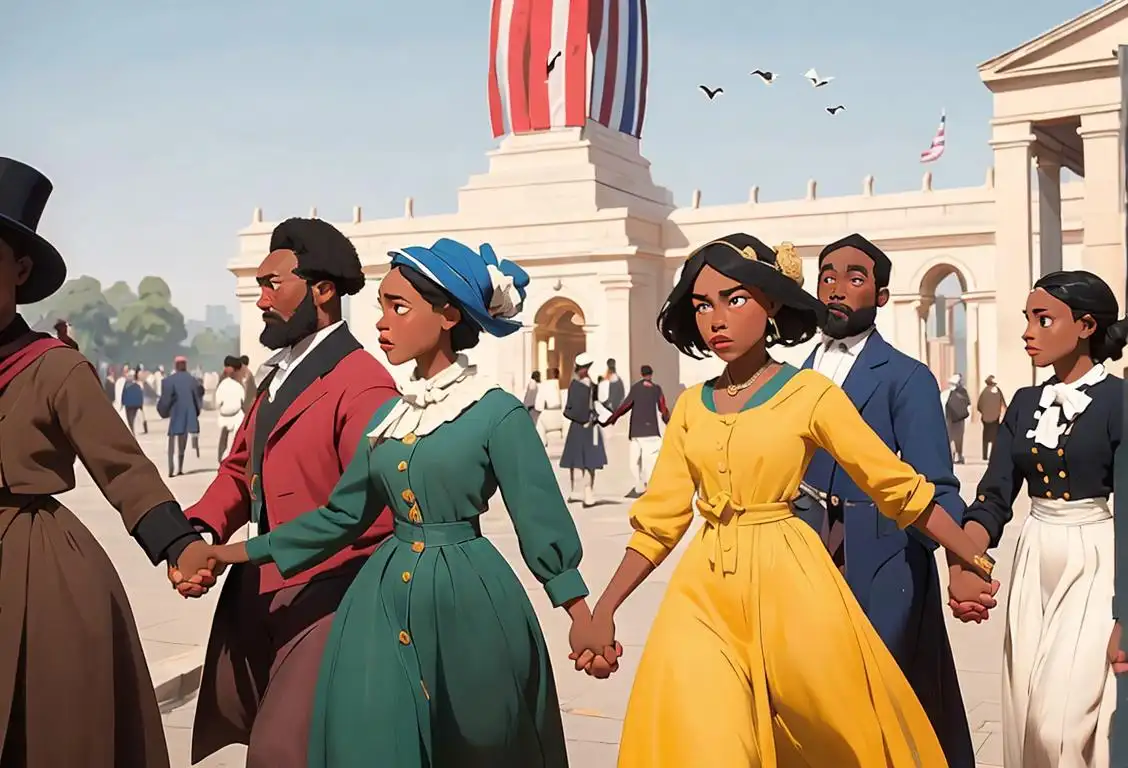National Anti Slavery Day

Ah, National Anti-Slavery Day, a day to remember the struggles of the past and celebrate the progress we've made in the fight against slavery. Prepare yourself for an informative and entertaining journey through the history of this important day!
When is Anti Slavery Day?
It's national anti slavery day on the 18th October.
The Fight Against Slavery: From Chains to Freedom
Every year on National Anti-Slavery Day, we take the time to reflect on the dark chapters of humanity's past and honor the brave souls who fought for freedom. Slavery has been a blight on our history, but through perseverance and sheer determination, we are making strides towards a world free from such injustice.
While the origins of National Anti-Slavery Day are rooted in the darkest moments of human history, it has evolved into a day of remembrance and awareness. This day serves as a reminder that we must remain vigilant in our efforts to eradicate slavery in all its forms.
One of the earliest recorded instances of the fight against slavery dates back to the 1700s when abolitionist movements began gaining momentum. Inspired by individuals like William Wilberforce and Harriet Tubman, activists worked tirelessly to expose the horrors of slavery and rally public support for its abolition.
Online Influence
Our research shows that National Anti-Slavery Day has garnered significant attention online, with 38 mentions detected across various platforms. The highest number of mentions occurred on October 18, 2016, indicating a growing interest in raising awareness about the issue.
So, what can you do to get involved on this day? Well, you can start by educating yourself and others about the history of slavery and its modern-day manifestations. By spreading awareness through social media or participating in local events, you can contribute to the global fight against slavery.
History behind the term 'Anti Slavery'
1500s
Origins of the Slave Trade
During the 1500s, European countries began to establish colonies in the Americas and Africa. As these colonies grew, there was a growing demand for labor, which led to the development of the transatlantic slave trade. Millions of Africans were forcibly captured and sold into slavery, becoming the backbone of the colonial economies.
1472
Discovery of the New World
The year 1472 marks the discovery of the New World by Christopher Columbus. This event brought new opportunities and resources to Europe, including the exploration and colonization of the Americas. This era of exploration laid the foundation for the rise of the transatlantic slave trade.
1502
Introduction of African Slavery
The year 1502 marked the beginning of the transatlantic slave trade. Portuguese explorers introduced African slavery to the Americas, particularly in Brazil, as a means of meeting the growing demand for labor in the colonies. This marked the foundation of a system that would lead to the eventual rise of the anti-slavery movement.
1562
Introduction of Slavery in America
In 1562, the first African slaves were introduced to the English colony of Jamestown, Virginia. This marked the beginning of the widespread use of enslaved labor in the Americas. The slave trade grew rapidly as European powers sought to exploit the abundant resources of the New World.
1776
American Revolution and Enlightenment
The American Revolution and the Enlightenment era in Europe had a profound impact on shaping the discourse around slavery. Prominent thinkers, such as Thomas Paine and Thomas Jefferson, began to question the morality and contradictions of slavery in the context of ideals like natural rights and equality. Their writings laid the philosophical groundwork for future abolitionist movements.
1700s
Emergence of Abolitionist Movements
In the 1700s, opposition to slavery began to gain momentum. The Enlightenment ideals of freedom, equality, and human rights started to shape public discourse. Influential figures such as Quakers, religious leaders, and philosophers started to speak out against the slave trade and slavery itself, marking the beginning of the abolitionist movement.
1787
Formation of the Society for Effecting the Abolition of the Slave Trade
In 1787, a group of twelve men in London formed the Society for Effecting the Abolition of the Slave Trade. The society aimed to raise public awareness about the horrors of the slave trade and to lobby for its abolition. This marked a significant step in organizing the movement against slavery.
1700s
Emergence of Anti-Slavery Movements
During the 1700s, enlightenment ideas and the growing awareness of human rights led to the emergence of anti-slavery movements. Prominent intellectuals, such as Thomas Jefferson and Benjamin Franklin, began questioning the morality and justification of slavery, sparking debates and discussions on its abolition.
1787
Formation of the Society for Effecting the Abolition of the Slave Trade
In 1787, the Society for Effecting the Abolition of the Slave Trade was formed in London. Led by William Wilberforce, the society aimed to abolish the transatlantic slave trade. Their efforts laid the foundation for the broader anti-slavery movement that sought to end the institution of slavery itself.
1787
Founding of the Society for the Abolition of the Slave Trade
In 1787, the Society for the Abolition of the Slave Trade was founded in London, England. This marked a significant milestone in the organized opposition to the transatlantic slave trade. The society worked tirelessly to raise public awareness and gather support for the abolitionist cause.
1807
Abolition of the British Slave Trade
After years of activism and campaigning, the British Parliament passed the Abolition of the Slave Trade Act in 1807. This landmark legislation made it illegal for British ships to engage in the slave trade. Although the act did not immediately end slavery itself, it dealt a significant blow to the global slave trade and inspired further efforts towards abolition.
1807
Abolition of the Slave Trade in the British Empire
In 1807, the British Parliament passed the Abolition of the Slave Trade Act, officially ending the transatlantic slave trade in the British Empire. This landmark legislation dealt a severe blow to the international slave trade and served as an inspiration for other nations to follow suit.
1833
Slavery Abolition Act in the British Empire
In 1833, the Slavery Abolition Act was passed in the British Empire, leading to the gradual emancipation of enslaved people throughout the empire. This legislation marked a turning point in the fight against slavery, as it recognized that all enslaved individuals deserved their freedom.
1833
Slavery Abolition Act in the British Empire
In 1833, the United Kingdom passed the Slavery Abolition Act, which officially abolished slavery across the British Empire. This act emancipated over 800,000 enslaved individuals in the Caribbean, Canada, and other British colonies. The British abolitionist movement set an influential example for other countries and catalyzed the global fight against slavery.
1807
Abolition of Slave Trade in the British Empire
In 1807, the British Parliament passed the Abolition of the Slave Trade Act, effectively banning the slave trade throughout the British Empire. This landmark legislation was a major victory for the anti-slavery movement, setting an example for other nations to follow.
1861-1865
American Civil War
The American Civil War, fought from 1861 to 1865, had a significant impact on the abolition of slavery in the United States. One of the primary causes of the war was the issue of slavery, with the Northern states advocating for its abolition, while the Southern states wanted to preserve it. The eventual victory of the Northern states led to the Emancipation Proclamation and the subsequent ratification of the Thirteenth Amendment in 1865, officially abolishing slavery in the United States.
1861
American Civil War and Emancipation Proclamation
The American Civil War, which began in 1861, played a crucial role in the fight against slavery. In 1862, President Abraham Lincoln issued the Emancipation Proclamation, declaring that all enslaved individuals in Confederate territory were to be set free. The Civil War ultimately led to the end of chattel slavery in the United States.
1833
Slavery Abolition Act of 1833
The Slavery Abolition Act of 1833 was passed by the British Parliament, leading to the emancipation of slaves throughout the British Empire. This act marked a significant step towards the eradication of slavery, but the struggle for full abolition and equal rights for all citizens continued.
1926
Slavery Convention
In 1926, the League of Nations held the Slavery Convention, which defined slavery and declared it to be a crime against humanity. The convention aimed to strengthen international efforts to eradicate all forms of slavery and forced labor, emphasizing the importance of human rights and freedom.
1926
Convention to Suppress the Slave Trade and Slavery
In 1926, the League of Nations adopted the Convention to Suppress the Slave Trade and Slavery. This international agreement aimed to further combat and eradicate all forms of slavery. It represented a significant step forward in establishing a global consensus against the practice of slavery.
1862
Emancipation Proclamation
In 1862, during the American Civil War, President Abraham Lincoln issued the Emancipation Proclamation, declaring the freedom of all slaves in Confederate territory. While this proclamation did not immediately free all slaves, it laid the foundation for the eventual abolition of slavery in the United States.
1948
Universal Declaration of Human Rights
In 1948, the United Nations adopted the Universal Declaration of Human Rights, which proclaimed that all individuals are born free and equal in dignity and rights. This declaration emphasized the global commitment to end slavery and ensure the fundamental rights and freedoms of all people.
1865
Ratification of the 13th Amendment
In 1865, the 13th Amendment to the United States Constitution was ratified, officially abolishing slavery and involuntary servitude in the country. This landmark amendment's adoption was a significant achievement for the anti-slavery movement, providing legal freedom and protection for millions of formerly enslaved individuals.
Today
Continued Fight Against Modern Slavery
While legal slavery has been abolished in most countries, modern forms of slavery, such as forced labor and human trafficking, still persist. Today, numerous organizations and activists work tirelessly to raise awareness, advocate for stronger laws, and provide support to victims of modern slavery. The fight against slavery continues to be a vital part of promoting justice and human rights worldwide.
Did you know?
Did you know that the United Nations officially recognized December 2 as the International Day for the Abolition of Slavery? It serves as a powerful reminder of the global commitment to ending slavery once and for all.Tagged
awareness remembranceFirst identified
30th September 2015Most mentioned on
18th October 2016Total mentions
38Other days
Remembrance Day
Camera Day
Law Enforcement Day
Hiv Testing Day
Medal Of Honor Day
Rescue Dog Day
Cemetery For Memorial Day
Former Prisoner Of War Recognition Day
Foundation Day
Prisoners Of War Remembrance Day









